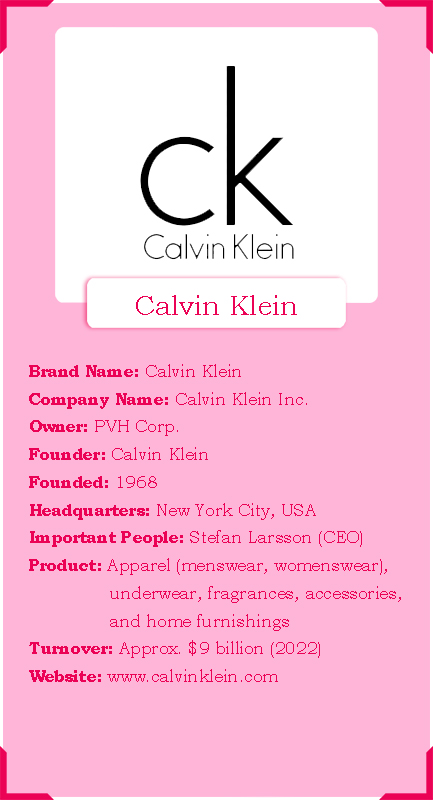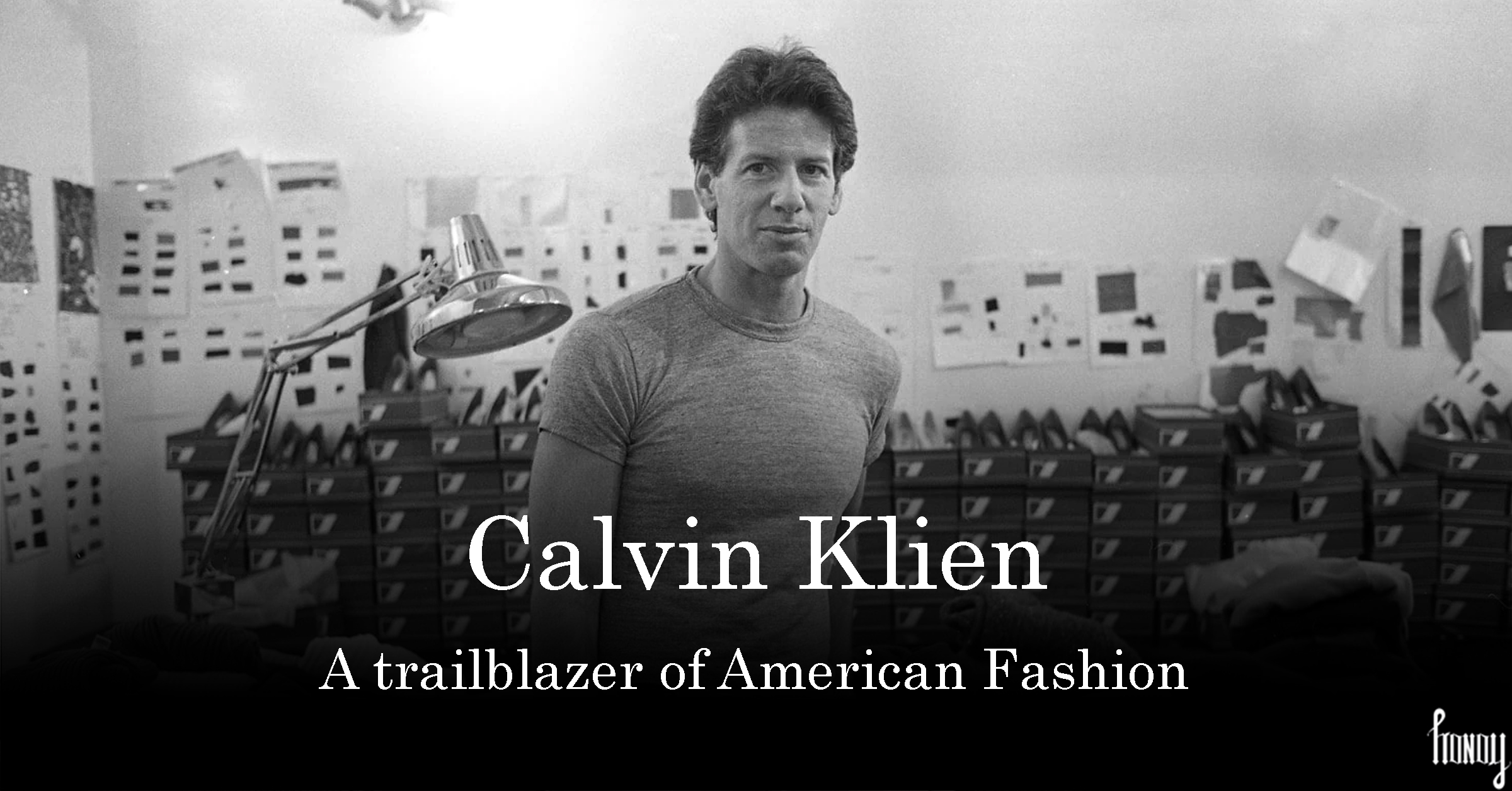Introduction to Calvin Klein

Calvin Klein, a name synonymous with modern American fashion, revolutionized the industry with his minimalist designs, provocative advertising, and impeccable branding. From redefining casual wear to elevating denim and underwear, Klein’s impact on fashion transcends beyond clothing—it shaped a cultural movement. His designs epitomized a refined yet daring aesthetic that challenged traditional norms, making him a trailblazer of contemporary fashion.
Klein once said, “The best thing is to look natural, but it takes makeup to look natural.” This statement encapsulates his design philosophy of creating fashion that appears effortless but is intricately crafted. This blog will explore the journey of Calvin Klein—from his humble beginnings to becoming a global fashion powerhouse. We’ll dive deep into his career, his signature style, and his enduring legacy in the fashion world.
Early Life and Background
Born Calvin Richard Klein on November 19, 1942, in the Bronx, New York, he was raised in a family of Eastern European Jewish immigrants. His mother, Flore, was a homemaker with a keen interest in fashion, which played a significant role in shaping Klein’s future. Klein grew up sketching designs and was heavily inspired by the urban environment around him.
Klein’s formal education began at the High School of Art and Design, and he later attended the Fashion Institute of Technology (FIT) in New York City, where he honed his skills. His early inspirations came from designers like Yves Saint Laurent and the simplicity of American sportswear. After graduation, he worked as an apprentice for a coat manufacturer, taking his first steps into the fashion industry.
Career Beginnings
Klein’s entry into the fashion industry came at a time when minimalist design and tailored silhouettes were gaining popularity. In 1968, with just $10,000 borrowed from a friend, Klein and his business partner, Barry Schwartz, launched Calvin Klein Limited—a coat shop located in New York’s York Hotel. His clean, sophisticated designs immediately caught the attention of buyers, and within a year, Klein’s creations were featured in the upscale department store Bonwit Teller.
Initially focusing on coats and dresses, Klein’s collections soon expanded to include women’s sportswear, marking the beginning of his iconic fashion empire. However, it wasn’t all smooth sailing; the competition in the American fashion industry was fierce, and Klein faced numerous challenges in gaining recognition. Nevertheless, his understated, luxurious pieces soon set him apart from his peers.
Rise to Fame

Klein’s breakthrough moment came in the early 1970s when he introduced his signature line of tailored women’s wear that embodied an elegant and minimalist aesthetic. His designs were timeless, reflecting a blend of European sophistication with American pragmatism. This approach won him the prestigious Coty Award in 1973, followed by two more Coty Awards in 1974 and 1975, establishing Klein as a dominant force in fashion.
A pivotal moment in his career came in 1978 when Calvin Klein introduced his first line of jeans. Branded simply with his name, these denim pieces became a cultural phenomenon, largely thanks to a controversial ad campaign featuring a 15-year-old Brooke Shields proclaiming, “Nothing comes between me and my Calvins.” This bold marketing strategy pushed Klein’s name into the global spotlight, making him one of the most talked-about designers of his time.
Signature Style and Innovations
Calvin Klein’s signature style is characterized by its minimalism, clean lines, and understated luxury. His garments often evoke a sense of ease, confidence, and sensuality, whether it’s a simple pair of jeans or a sophisticated evening gown. Klein’s designs rejected the ornate trends of the 1970s and 80s, favoring instead monochromatic color schemes, subtle tailoring, and versatile fabrics like cotton, denim, and wool.
One of his most significant innovations was his redefinition of underwear. In the 1980s, Klein introduced men’s and women’s underwear lines that were no longer viewed as basic, utilitarian garments but rather as fashion statements. The sleek, form-fitting designs, paired with daring advertising campaigns featuring celebrities like Mark Wahlberg and Kate Moss, transformed how people viewed intimate wear.
Impact on the Fashion Industry
Calvin Klein’s influence on the fashion industry cannot be overstated. He was one of the pioneers who blurred the lines between high fashion and mass-market appeal. Klein played a key role in popularizing designer jeans, making them a staple in everyday wardrobes. His minimalist aesthetic also shaped fashion trends for decades, influencing designers like Tom Ford and Narciso Rodriguez.
Beyond fashion, Klein was an innovator in branding and marketing. His provocative, sometimes controversial, ad campaigns were ahead of their time, pushing societal boundaries and addressing themes of sexuality, youth, and identity. These campaigns made fashion more than just about clothing; they became part of a larger cultural narrative.
Notable Collaborations and Projects
Over the years, Calvin Klein has collaborated with a variety of celebrities, models, and photographers, creating some of the most memorable campaigns in fashion history. His partnership with photographer Richard Avedon resulted in iconic images that defined the brand’s edgy, avant-garde image.
In addition to his work in fashion, Klein has dabbled in costume design, contributing to films and theatrical productions. His philanthropic efforts are also notable, as he has supported numerous causes, including AIDS research and cancer charities, further cementing his reputation as a designer with a social conscience.
Personal Life and Public Persona
Calvin Klein’s personal life has often been the subject of media attention. He married Jayne Centre in 1964, with whom he had a daughter, Marci, but they later divorced in 1974. Klein later married his assistant Kelly Rector in 1986, although they too divorced in 2006.
Klein has always been a somewhat enigmatic figure, known for his quiet demeanor in public. Despite his fame, he maintained a relatively private life, letting his work speak for itself. His openness about his sexuality and support for LGBTQ+ rights has made him a respected figure in the community.
Legacy and Continuing Influence
Calvin Klein’s legacy is firmly rooted in the transformation of American fashion. His contributions to minimalism, branding, and the democratization of luxury have made him a lasting influence on both the fashion industry and popular culture. Today, his brand remains one of the most recognizable and influential in the world, with a global presence spanning over 100 countries.
After Calvin Klein stepped down from his role in the company in 2002, the brand underwent a series of transitions in leadership and creative direction. Several designers have succeeded Klein, each bringing their own vision and interpretation to the iconic brand, while maintaining its core principles of minimalism, modernity, and sensuality. Here’s a closer look at the notable successors of Calvin Klein and their contributions to the label.
Francisco Costa (2003–2016)
Francisco Costa, a Brazilian-born designer, was appointed as the creative director of Calvin Klein’s women’s collection in 2003, following Calvin Klein’s exit. Costa had previously worked with Tom Ford at Gucci and had an understanding of modern, sleek designs. His minimalist approach, which was aligned with Klein’s aesthetic, helped maintain the brand’s signature look. However, Costa infused his designs with a more architectural and sculptural quality.
Costa was particularly known for his use of innovative fabrics and his attention to craftsmanship. His tenure brought several accolades, including two CFDA Awards for Womenswear Designer of the Year in 2006 and 2008. He successfully continued Klein’s legacy of understated elegance while keeping the brand relevant in the competitive luxury market.
Italo Zucchelli (2003–2016)
Alongside Francisco Costa, Italian-born Italo Zucchelli became the creative director of Calvin Klein’s men’s line in 2003. Like Costa, Zucchelli had previously worked under Calvin Klein and understood the brand’s DNA. His designs emphasized sharp tailoring and clean lines, adhering to the minimalist aesthetic Klein was known for.
Zucchelli’s approach to menswear also included more experimental materials and athletic influences, reflecting the growing trend of sportswear in high fashion. He was instrumental in ensuring Calvin Klein’s relevance in the evolving menswear landscape, catering to a younger and more fashion-forward audience while preserving the timeless qualities of the brand.
Raf Simons (2016–2018)
In 2016, Calvin Klein appointed Belgian designer Raf Simons as its chief creative officer, marking a new era for the brand. Simons’ arrival was met with great anticipation due to his reputation for avant-garde designs and his previous successes at Dior and his own label.
Simons’ vision for Calvin Klein was ambitious, aiming to merge high fashion with American pop culture. He rebranded the label as “Calvin Klein 205W39NYC” and introduced more conceptual and art-driven collections. His work was heavily inspired by American cinema, art, and the cultural landscape, which was a departure from Klein’s minimalist roots. Simons’ bold approach earned him critical acclaim, including CFDA awards for both Menswear and Womenswear Designer of the Year in 2017.
However, despite the praise, his collections did not resonate commercially, and Simons left the company in late 2018 after just two years. His departure led to a reevaluation of the brand’s direction.
Post-Raf Simons Era
Following Raf Simons’ departure, Calvin Klein underwent significant restructuring. The brand decided to shift focus away from its high-fashion runway collections, shuttering the Calvin Klein 205W39NYC line and opting to concentrate on its core categories, including underwear, denim, and fragrances—areas that have always been the company’s most profitable.
Instead of appointing a single successor to Simons, the brand adopted a more collaborative, corporate approach. PVH Corp., Calvin Klein’s parent company, reorganized the creative teams and decided to focus on more consumer-driven categories. This pivot marked a return to the brand’s commercial roots, prioritizing profitability over high fashion experimentation.
Conclusion
Calvin Klein’s contributions to fashion are nothing short of monumental. From his minimalist designs to his innovative marketing strategies, he has left an indelible mark on the fashion industry. Klein’s work not only changed the way people dress but also how they perceive fashion itself—as an extension of personal identity, culture, and desire. For anyone interested in exploring the evolution of modern fashion, Calvin Klein’s collections and legacy serve as a powerful testament to the power of simplicity, innovation, and vision.
Whether you’re a long-time admirer or new to his designs, there’s always something to discover in the world of Calvin Klein. Please write below in the comments and let me know how you found the information in this blog. Also, it would be great if you will share with me your favourite Calvin Klein fashion moment.




























